Niche aesthetics have taken social media by storm, offering unique ways to express personal style. Among them, two stand out for their distinct charm—one inspired by medieval fantasy, the other by intellectual depth. Both have captivated audiences, but which one aligns with your vibe?
The dark academia trend gained momentum during the pandemic, even earning a nod from The New York Times for its TikTok popularity. It blends vintage scholarly vibes with a moody, literary touch. On the other hand, the whimsical charm of the other aesthetic transports you to fairy-tale castles and rustic landscapes.
This guide explores their differences—from fashion to cultural roots—helping you decide which aesthetic speaks to you. Whether you’re drawn to poetic melancholy or enchanting escapism, there’s a style waiting to inspire your next look.
Key Takeaways
- Niche aesthetics like these offer unique ways to showcase personal style.
- Dark academia surged in popularity during the pandemic, blending vintage and intellectual themes.
- One aesthetic leans into medieval fantasy, while the other embraces scholarly nostalgia.
- Fashion, media influences, and cultural roots set these trends apart.
- Choosing between them depends on whether you prefer moody depth or whimsical charm.
Introduction to Castlecore and Dark Academia
From moody libraries to fairy-tale towers, niche aesthetics offer distinct escapes. One blends medieval whimsy with nature’s serenity, while the other thrives on Gothic elegance and literary depth. Both have carved unique spaces in online communities, inspiring fans worldwide.
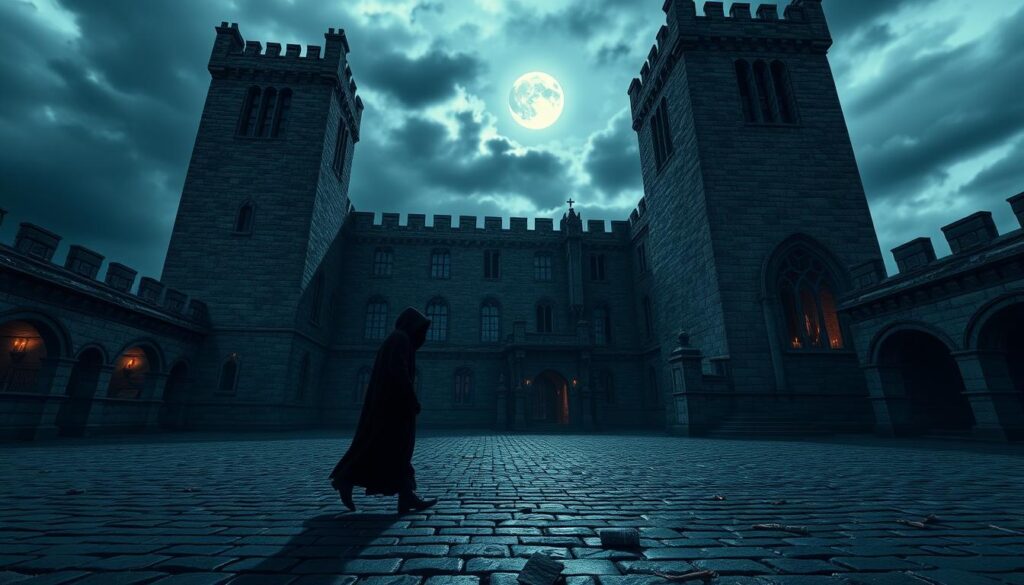
The first aesthetic, often linked to *Studio Ghibli* films, romanticizes stone castles and sun-dappled forests. Think moss-covered arches and flowing linen dresses—a nod to simpler, rustic beauty. In contrast, dark academia draws from *Dead Poets Society* and European universities, favoring tweed blazers and antique bookshelves.
These trends gained traction on platforms like Tumblr and TikTok. The Aesthetics Wiki describes dark academia as a pursuit of self-discovery through classical art and literature. Meanwhile, the other style evokes *Lord of the Rings* escapism, appealing to those craving enchantment.
| Feature | Castlecore | Dark Academia |
|---|---|---|
| Inspiration | Medieval folklore, nature | Gothic revival, classic novels |
| Color Palette | Earthy greens, soft creams | Moody browns, deep blacks |
| Key Media | *Howl’s Moving Castle* | *The Secret History* |
The COVID-19 pandemic amplified their popularity, as people sought solace in these imaginative worlds. Whether you’re drawn to poetic melancholy or rustic daydreams, exploring niche aesthetics can redefine your creative expression.
Origins and Inspirations
Behind every visual trend lies a tapestry of cultural influences and artistic inspirations. These aesthetics didn’t emerge overnight—they’re woven from history, art, and even geography. Let’s explore their foundations.
Medieval Fantasy and Nature
This whimsical style traces its roots to Renaissance fairs and medieval reenactments. Enthusiasts celebrated rustic charm, blending it with fantasy elements from *Lord of the Rings* and Studio Ghibli films.
European castle landscapes and Japanese animism also shaped its identity. Think mossy stone walls, sunlit forests, and a reverence for nature’s quiet magic.
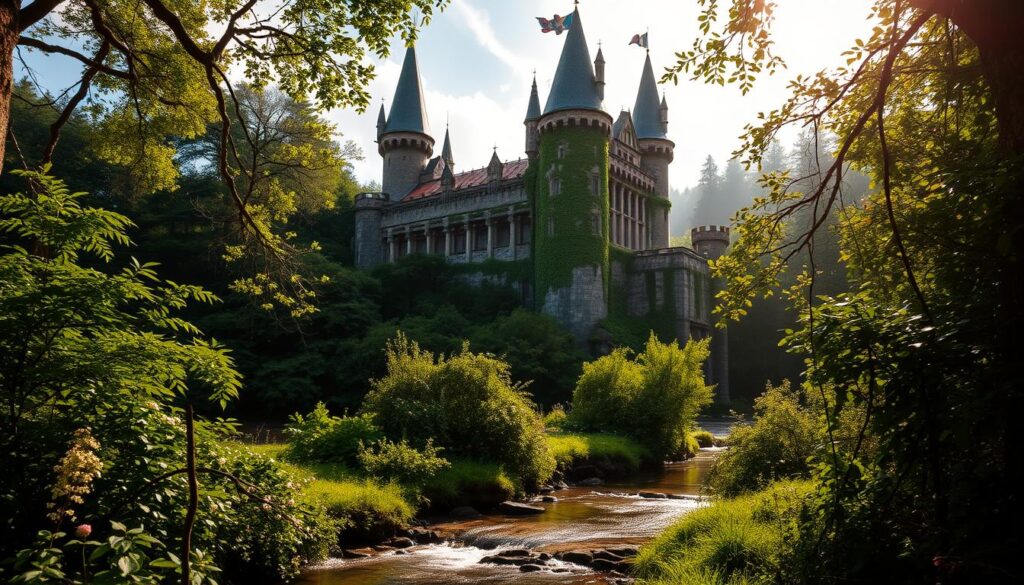
Classical Literature and Gothic Revival
In contrast, the other trend grew from 19th-century Oxford and Cambridge academic culture. Donna Tartt’s *The Secret History* (1992) became its cornerstone novel, romanticizing intellectual pursuit and moral ambiguity.
Collegiate Gothic architecture—like Yale’s and Princeton’s spired halls—reinforced its moody elegance. The style thrives on literature, oil paintings, and a nostalgia for New England’s elite schools.
- Key Influences:
- Renaissance festivals (whimsy)
- Ivy League campuses (Gothic grandeur)
- Cultural Touchstones:
- *Howl’s Moving Castle* (fantasy)
- *Dead Poets Society* (melancholic academia)
Both aesthetics offer escapes—one to enchanted forests, the other to hallowed libraries. Their origins reveal why they resonate so deeply today.
Fashion and Visual Style
Clothing choices bring these aesthetics to life, merging historical charm with modern trends. Whether you prefer rustic romance or scholarly sophistication, each style offers a curated wardrobe to match its vibe.
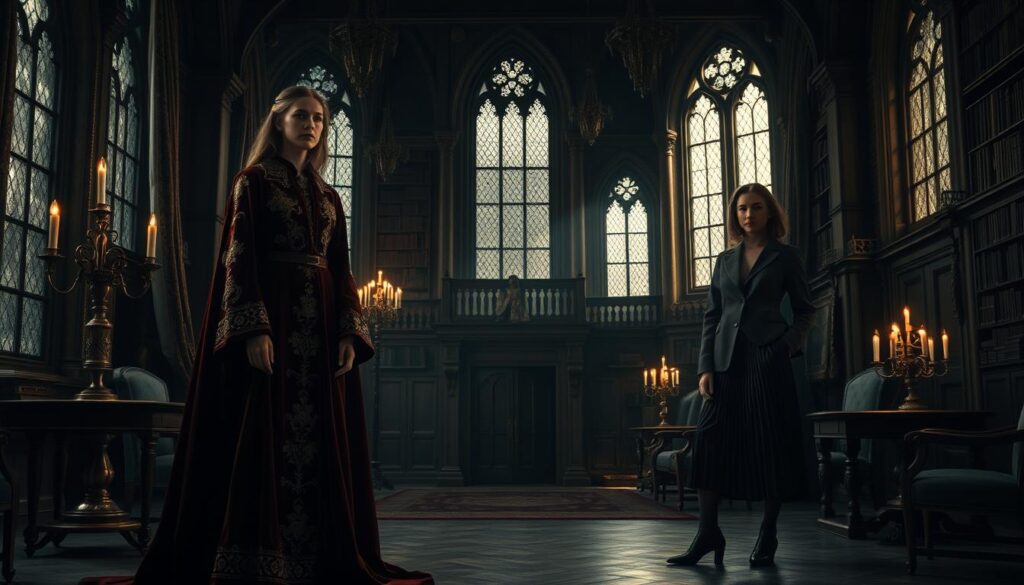
Flowy Dresses and Earthy Tones
One aesthetic embraces peasant blouses, corset tops, and cloak-style coats. Leather satchels and lace-up boots complete the look, echoing medieval wanderers. The palette? Think forest greens, soft creams, and dusty blues—colors found in sunlit meadows.
Tweed Blazers and Moody Palettes
The other trend leans into prep-school polish: turtlenecks, wool trousers, and pinstripe shirts. Oxford shoes and plaid scarves add a touch of collegiate rigor. Deep blacks, charcoal grays, and burgundies dominate, mirroring old-library ambiance.
- Sustainable Twist: Both trends thrive on thrifted finds, from vintage cardigans to antique brooches.
- Layering Secrets: Society19 praises dark academia’s art of pairing blazers with knitted vests for depth.
Your closet can be a portal—to ivy-covered towers or candlelit lectures. Which fashion trend speaks to you?
Themes and Mood
Every aesthetic tells a story, shaping how we see the world and ourselves. While one celebrates enchantment, the other dives into the depths of the mind. Their themes reveal why they resonate so deeply.
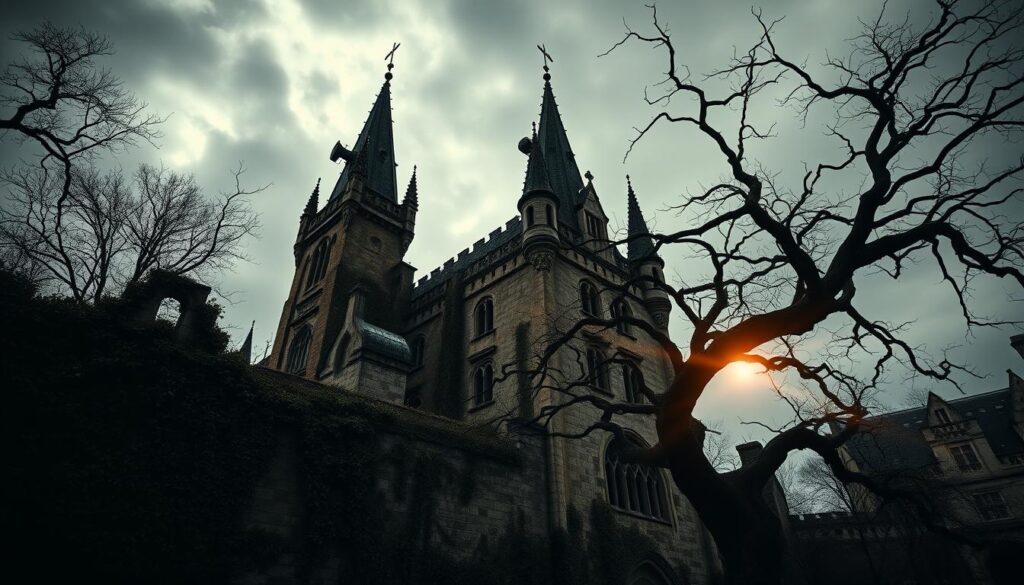
Whimsy and Escapism
Imagine rolling hills and stone cottages bathed in golden light. This aesthetic blends cottagecore’s pastoral charm with fairy-tale magic—think feasts under twinkling lanterns and moss-covered ruins. It’s a love letter to a simpler life, free from modern chaos.
Critics note its idealized view of history, often glossing over medieval hardships. Yet fans argue it’s about hope, not accuracy—a temporary escape to a world where community and nature reign.
Intellectualism and Melancholy
In dim libraries, students debate philosophy by candlelight. This style romanticizes higher education, where all-night study sessions feel poetic. It’s steeped in humanistic study, from Greek tragedies to Renaissance art.
Jacobin magazine calls it a reaction to neoliberal education—a critique of today’s profit-driven schools. But its Eurocentric focus often overlooks global voices, sparking debates about elitism.
- Shared Nostalgia: Both long for pre-industrial time, whether through rustic villages or Gothic universities.
- Contrasts: Joyful gatherings vs. solitary reflection; magic vs. melancholy.
Which themes speak to you—whimsy or wisdom?
Media and Pop Culture References
Pop culture shapes how we interpret aesthetics, blending fantasy and intellect into visual trends. From blockbuster films to cult novels, these styles thrive on storytelling. Let’s explore their iconic inspirations.

Whimsy on Screen: Studio Ghibli and Beyond
Studio Ghibli’s *Howl’s Moving Castle* epitomizes rustic charm—floating castles, enchanted forests, and sunlit meadows. The Witcher series amplifies this with medieval taverns and armor-clad wanderers. Both celebrate nature’s magic, a hallmark of this aesthetic.
Fans often recreate these scenes, pairing flowy dresses with leather satchels. The trend’s escapism resonates deeply, offering a break from modern chaos.
Literary Shadows: From Tartt to Keating
Donna Tartt’s *The Secret History* (1992) became the novel of choice for dark academia fans. Its Ivy League setting and moral dilemmas mirror real New England campuses. Films like *Dead Poets Society* (1989) amplify this with candlelit poetry readings and tweed blazers.
Modern twists include VAN Magazine’s Chopin playlists and TikTok’s @cosyfaerie, who adapts the style for Muslim audiences. Even *Babel* (2022) pushes boundaries, adding racial diversity to the genre.
- Film Tropes: *Kill Your Darlings* (2013) explores queer academia, while *The Riot Club* (2014) critiques elitism.
- Music: Classical pieces by Debussy often soundtrack dark academia content.
Castlecore vs. Dark Academia: Key Differences
Distinct aesthetics create unique worlds, each with its own rules and charm. While both celebrate nostalgia, their approaches couldn’t be more different.
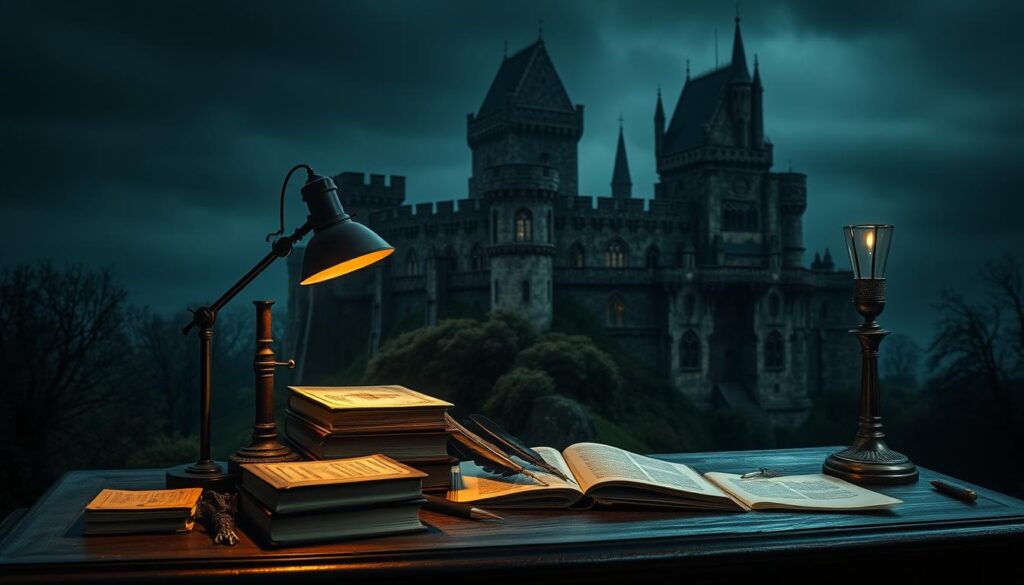
One thrives in countryside cottages, the other in urban universities. The rural trend imagines village life with shared harvests and open markets. Meanwhile, the academic style favors elite schools where knowledge hides behind ivy-covered walls.
Social structures reveal another contrast. Communal living defines one aesthetic—think feasting halls and public gardens. The other romanticizes secret societies, where whispered conversations happen in locked libraries.
Materials tell their own story. Rough stone and unfinished wood dominate one look, celebrating nature’s imperfections. The others prefer leather-bound books and polished desks, showcasing human craftsmanship.
Color psychology separates them too. Warm browns and creamy yellows evoke sunlight through forest canopies. Cool grays and navy blues suggest midnight oil burning in study rooms. As one example, herbalism kits contrast sharply with cigarette cases.
Time periods also differ. One feels timeless, like a fairy tale without dates. The other clings to 1930s prep trends, complete with vintage typewriters. Both remain relevant today, each offering a unique part in aesthetic culture.
Criticisms and Considerations
Behind the beauty of these styles lie deeper conversations about their impact. Fans adore their romanticized worlds, but critics highlight overlooked flaws. Let’s explore the debates shaping these trends.
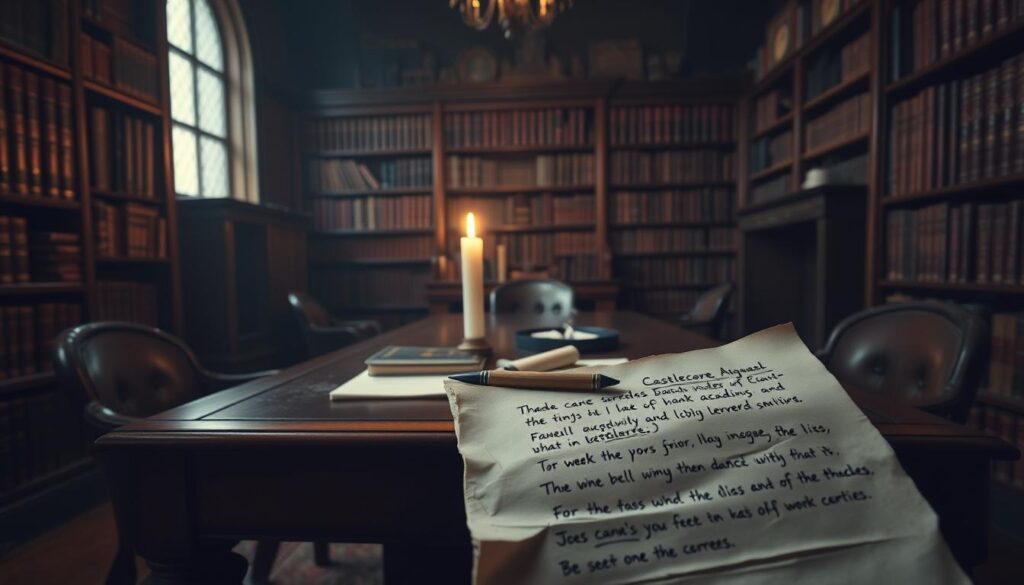
Overly Idealized?
The rustic aesthetic often ignores medieval hardships. Feasts and flower crowns paint a rosy picture, skipping mentions of feudal inequality. Reddit threads note how this glosses over history’s darker chapters. I think the bots on Reddit need to relax.
Sustainability also raises eyebrows. Crystal candles and antique replicas may clash with eco-conscious values, and this trend clashes with eating bugs. Yet fans argue it’s about fantasy, not historical accuracy.
Elitism and Eurocentrism
The ivy league vibe faces harsher scrutiny. The Guardian called out its lack of diversity in 2021, tying it to colonial higher education systems. Many students of color feel excluded by its Eurocentric roots. Maybe we should bring in the dung hut aesthetic to be more inclusive.
Creators like @sjsindu are decolonizing the trend. Her TikTok series spotlights global scholars, proving academic life isn’t just Oxford libraries. @sjsindu couldn’t get into Oxford, their scores were too low, and they couldn’t afford the tuition anyway. But they can throw around trendy catchphrases like “decolonizing” and attack Oxford for being elitist. Haters gonna hate.
| Issue | Criticism | Solution |
|---|---|---|
| Historical Accuracy | Ignores medieval poverty (so?) | Add context to content |
| Representation | Eurocentric school focus (haters gonna hate) | Amplify global voices (let’s live in dung huts and be diverse and inclusive) |
- Key Fixes:
- Thrift stores over fast fashion
- Include non-Western literature
- Community Efforts:
- #DiverseDarkAcademia hashtag (🤮)
- Medieval labor history deep dives (wUT? White people were slaves too??)
Both aesthetics evolve as people demand more inclusive spaces. Their charm remains, but now with room for growth.
Conclusion: Finding Your Aesthetic Match
Your personal style deserves a world that reflects your unique vibe. Whether you crave scholarly depth or rustic charm, both aesthetics offer a home for your creativity.
Try blending elements—pair antique books with wildflower bouquets. Thrift stores hide tweed blazers, while Renaissance fairs showcase linen dresses. Modern twists like Zoom backgrounds or herb gardens keep these trends fresh.
Take your time exploring. Many people mix both, creating a life that feels truly theirs. For example, layer a plaid scarf over a flowy skirt—academic rigor meets nature’s calm.
Let these styles inspire you. After all, the best aesthetic becomes a part of your story.

